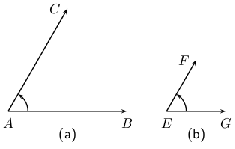| << Chapter < Page | Chapter >> Page > |
The purpose of this chapter is to recap some of the ideas that you learned in geometry and trigonometry in earlier grades. You should feel comfortable with the work covered in this chapter before attempting to move onto the Grade 10 Geometry Chapter or the Grade 10 Trigonometry Chapter . This chapter revises:
The two simplest objects in geometry are points and lines .
A point is a coordinate that marks a position in space (on a number line, on a plane or in three dimensions or even more) and is denoted by a dot. Points are usually labelled with a capital letter. Some examples of how points can be represented are shown in [link] .
A line is a continuous set of coordinates in space and can be thought of as being formed when many points are placed next to each other. Lines can be straight or curved, but are always continuous. This means that there are never any breaks in the lines. The endpoints of lines are labelled with capital letters. Examples of two lines are shown in [link] .

Lines are labelled according to the start point and end point. We call the line that starts at a point and ends at a point , . Since the line from point to point is the same as the line from point to point , we have that .
The length of the line between points
and
is
A line is measured in units of length . Some common units of length are listed in [link] .
| Unit of Length | Abbreviation |
| kilometre | km |
| metre | m |
| centimetre | cm |
| millimetre | mm |
An
angle is formed when two straight lines meet at a point. The point at which two lines meet is known as a
vertex . Angles are labelled with a
Angles are measured in degrees which is denoted by , a small circle raised above the text in the same fashion as an exponent (or a superscript).
Angles can also be measured in radians. At high school level you will only use degrees, but if you decide to take maths at university you will learn about radians.


The size of an angle does not depend on the length of the lines that are joined to make up the angle, but depends only on how both the lines are placed as can be seen in [link] . This means that the idea of length cannot be used to measure angles. An angle is a rotation around the vertex.

Notification Switch
Would you like to follow the 'Siyavula textbooks: grade 10 maths [ncs]' conversation and receive update notifications?